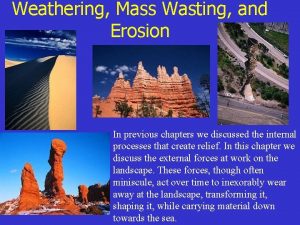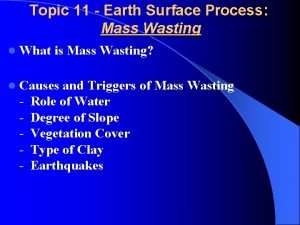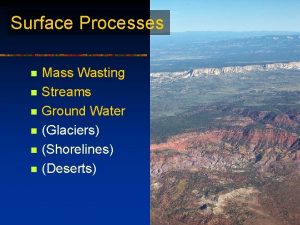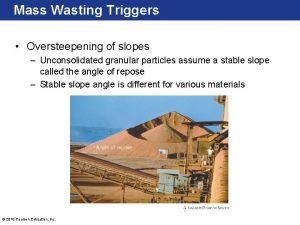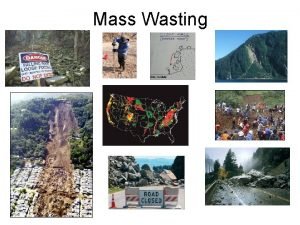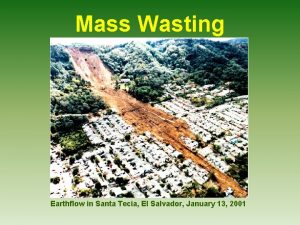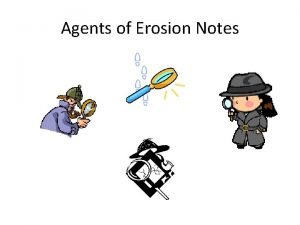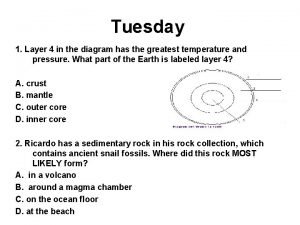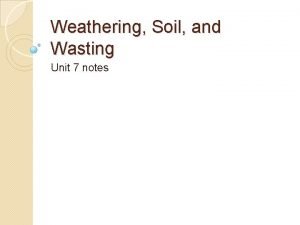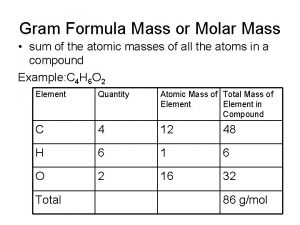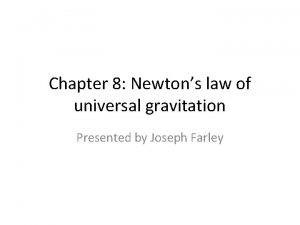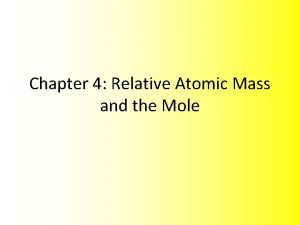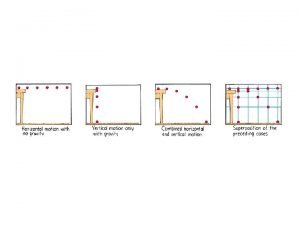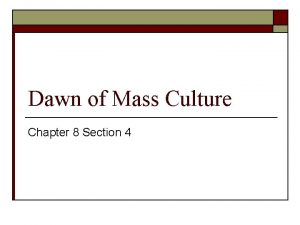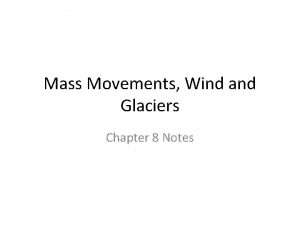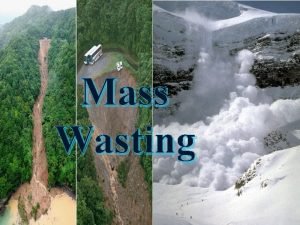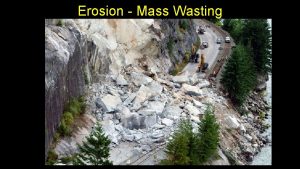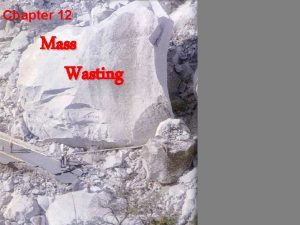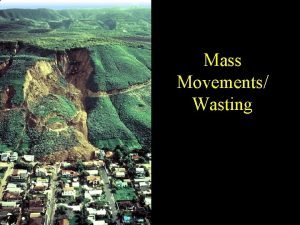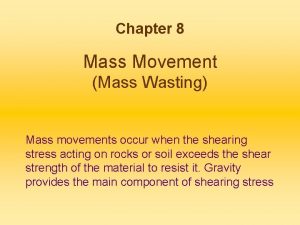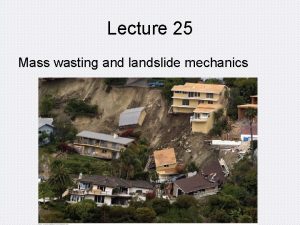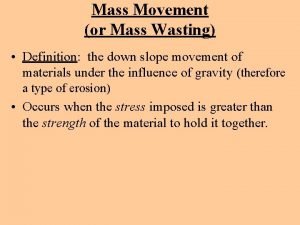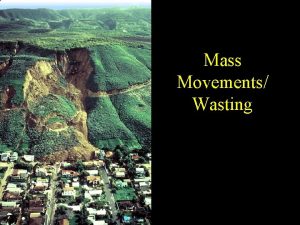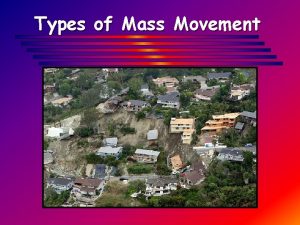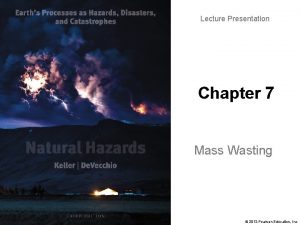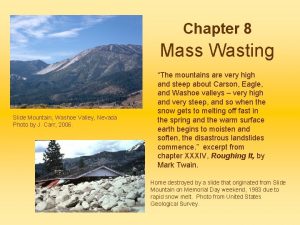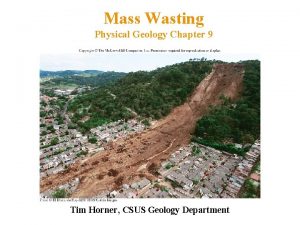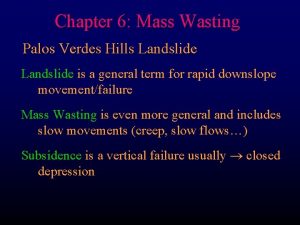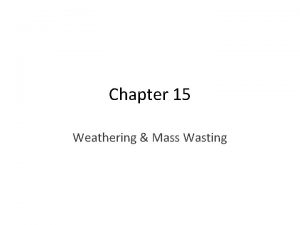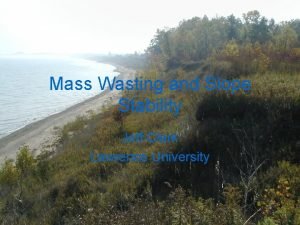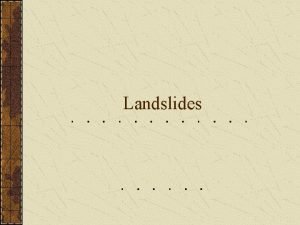Mass Wasting Chapter 13 What is mass wasting




































































- Slides: 68

Mass Wasting Chapter 13

What is mass wasting? • Basic part of the Rock Cycle • Breakdown of solid bedrock and redistribution of weathered components • Downslope movement of masses of rocks by gravity

Downslope Movement • Downslope journeys - imperceptibly slow, very fast, or somewhere in-between • Gravity tends to pull any mass on a sloping surface downhill As slope angle increases, gravity exerts a pull in the downslope direction.

The Role of Water • Not always a factor, but… • In some types of mass wasting – is very significant factor • Unconsolidated sediments behave differently when wet • Example: water and sand – drawn together by a force called capillary attraction (caused by surface tension)

The Role of Water (2) • Capillary force holds wet sand together • BUT - Saturation creates a slurry reducing friction - easily flows away • Large rock mass movement attributed to effects of increased water pressure within voids • Result - sudden failure (collapse of rock mass due to reduced friction)

Slope Failure CR - large slope failure in glaciomarine silt, Churchill River, Labrador.

Mass Wasting Processes • Landslide – any perceptible downslope movement of a mass of bedrock, regolith*, or both • Two broad categories: – Sudden failure of a slope: relatively coherent masses of rock or rock debris – Downslope flow of mixtures of solid material, water, and air *regolith – any solid materials, such as rock fragments or soil, lying on top of bedrock

Slope Failures • Collapse of rock or sediment mass • All hill slopes and mountain cliffs are susceptible due to constant pull of gravity • Rock debris transferred downslope and more stable slope condition is reestablished • Several types of slope failure: – Slumps, fails, and slides

Small rock slope failure in limestone on a strike slope in Jasper National Park, Canadian Rocky Mountains.

Slumps • Failure in which a downward and outward rotational movement of rock or regolith occurs along a curved concave-up surface • Most common • May occur singly or in groups • Range – 1 -2 meters, or 100 -1000’s meters • Numerous along roads and highways • Relate to construction activity

Slump Aerial of the La Conchita slump. Santa Barbara County, California. March 1995. Classic slump clearly detailing the scarp, slump and flow at base of the movement. An orchard is at the top of the slope.

La Conchita slump. September 1995. Ground level perspective of the slump.

La Conchita slump. September 1995. Destroyed home is still in place in 2002.

Slump 1. The top of the displaced block usually is tilted backward, producing a reversed slope. 2. Slumps are frequently associated with heavy rains or sudden shocks such as earthquakes. 3. Distinct episodes of slumping may be related to changing climatic conditions. 4. Slumping may recur seasonally and be associated with seepage of water into the ground during the rainy season.

A large slump on a high gravel terrace beside the Yakima River in central Washington has broken up a major highway and displaced it more than 100 m laterally into the river channel.

Collapse of slope to stand in the way of stream making a pond, located at Draix French South Alps.

Rockfalls and Debris Falls • Free falling of detached bodies of bedrock from a cliff or steep slope • May be single rock fragment or a huge mass of rock • Debris fall – similar to rockfall but consists of a mixture of rock material as well as vegetation

Forms due to gravity in the Alps (Dolomites, Italy): a debris cone (left side of the picture) and a landslide (rock-fall, right side of the picture in the foreground). Scale is given by some persons in the lower left corner.

Rockfalls and Debris Falls As the rock material falls off it gathers speed until it breaks on impact into a vast number of smaller pieces. These pieces continue to bounce, roll, and slide downslope before friction and decreasing slope angle bring them to a halt.

Rockfall due to wedge failures, Satluj Valley Higher Himalayas, India.

Debris flow influenced channel with levees, Payette River drainage of Idaho, USA. Debris flows are a common occurrence following fire on granitic soils.

Debris flow influenced first order channel creating a fan and rapid as it enters a higher order channel, Payette River drainage of Idaho USA.

Debris fan of Poucet torrent after a debris flow, located in the Maurienne Valley - French North Alps.

Rockslides and Debris Slides • Rockslide – the sudden downslope movement of a detached mass of bedrock (or of debris in a debris slide) along an inclined surface, such as a bedding plane • Common in high mountains with steep slopes • Rock debris range in size: sand to boulder

When large rock slides occur, the resulting deposit generally is a chaotic, jumbled mass of rock, with individual boulders that may measure tens of meters across.

Rock Debris • Talus – accumulation of angular rock fragments at the bases of steep cliffs; sloping outward from the cliff that supplies it • Angle of repose – the steepest angle at which the debris remains stable; typically lies between 300 and 370.

Talus cone at gravel pit, northern MI.

Talus A talus at the base of a steep mountain slope in the Brooks Range, in northern Alaska. Rock fall debris moving down a steep gully spreads at its base to form conical talus.

Angle of repose Coarse, angular limestone blocks stand at the angle of repose (about 300) in a talus below steep cliffs in the central Brooks Range, Alaska.

Sediment Flows • Mass wasting process in which particles move in such a way that the overall mass can be described as a flowing motion • Mixture of solid particles, water, and sometimes air

Sediment Flows Classification of sediment flows on the basis of their velocity and sediment concentration. The transition from a sediment-laden stream to a slurry flow occurs when the sediment concentration becomes so high that the stream no longer acts as a transporting agent; instead the direct action of gravity becomes the primary force causing the saturated sediment to flow.

Factors Controlling Flow • Relative proportions of solids, water, and air • Physical & chemical properties of sediment • Two classes of sediment flows: – Slurry flow – moving mass of water-saturated sediment – Granular flow – a mixture of sediment, air, and water; subdivided by flow velocity into: - creep, and debris avalanche

Slurry (wet) Flows Slurry - moving mass of water-saturated sediment

Slurry Flows • Sediment mixture often very dense • Boulders too large may roll with the flow • Flow cease results in poorly sorted (or even non-sorted) sediment • Three types of slurry flows – Solifluction – Debris flows – Mudflows

Solifluction – the very slow downslope movement of saturated soil and regolith

Solifluction This process lies at the lower end of the velocity scale for flowing sediment-water mixtures • Results in distinctive surfaces; lobes and sheets of debris • Occurs on hilltops in temperate and tropical latitudes

Two solifluction lobes, 1 -2 m thick, have crept slowly downslope and covered glacial deposits on the floor of the Orgiere Valley in the Italian Alps.

Debris Flows - Involves the downslope movement of unconsolidated regolith, the greater part being coarser than sand, at rates ranging from only about 1 m/yr to as much as 100 km/h Some begin with a slump or debris slide and continue to flow downslope Commonly have a tongue-like front Very irregular surfaces Associated with heavy rainfall

Debris Flow

Mudflows – a rapidly moving debris flow with a water content sufficient to make it highly fluid • Predominant particles no coarser than sand • Velocity at upper end of debris flow • Highly mobile • Travel rapidly along valley floors and spread laterally when no longer contained by valleys

Mudflows

Mudflows Passage of muddy debris flow along a canyon bottom near Farmington, Utah in June 1983. The bouldery front of a muddy debris flow advances from left to right along a stream channel in the wake of an earlier surge of muddy debris. The steep bouldery front, about 2 m high and advancing at 1. 3 m/s, acts as a moving dam, holding back the flow of muddy sediment upstream.

Mt. St. Helens Mudflows - During the 1980 eruption of Mount St. Helens in Washington, volcanic mudflows were channeled down valleys west and east of the mountain. Some mudflows reached the Columbia River, having traveled more than 90 km. Flow velocities were a high as 40 m/s and averaged 7 m/s.

Mudflow Deposit

Granular Flows • Largely dry with air filling the pores • Or, may be initially saturated with water but have a range of grain sizes and shapes that allows water to escape easily • Types of granular flow: – Creep and colluvium – Earthflows – Grainflows – Debris avalanches

Granular (dry) Flows Earthflow Debris Avalanche

Creep and Colluvium • The imperceptibly slow downslope movement of regolith • Steeply inclined rock strata are sometimes bent over in the downslope direction • Occurs at a rate too slow to be seen • Rates higher on steeper slopes than on gentle slopes • Rates increase with soil moisture increase

Creep – Effects of creep on surface features and on bedrock. Steeply inclined strata have been deformed near the surface by differential creep, so they appear folded. Telephone poles and fence posts affected by creep are tilted, stone fences are deformed, roadbeds are locally displaced, tree trunks may be bent, and gravestones are tilted or fallen.

Downslope tilting of steeply dipping sedimentary layers due to creep (near Marathon, West Texas). Copyright © Richard Hanson 2003

Hill slope processes (presumably sheet wash and soil creep) have removed approximately 1 meter of soil to expose the root system of the tree. On the other hand, the roots look pretty grizzly and uniform, so there may have been a landslide episode decades ago that stripped the topsoil off the hill. (Photo taken in the mountains immediately north of Lake Arrowhead, California. )

Shale Overturned by Creep – Beds of shale have been overturned by slow downslope creep on a hillside in the Laramie Basin, Wyoming.

Slump blocks in colluvium north of Pittsburgh, PA.

Earthflows • Among the more common mass-wasting features on the landscape are earthflows, granular flows having a velocity in the range of about 1 cm/day to several hundred m/h. • May remain active for several days, months, or even years • Made of weak regolith, predominantly silt or claysized particles • Occur on gentle to moderate steep slopes • Occur where ground is saturated

Earthflows At the top of a typical earthflow is a steep scarp, which is a cliff formed where slide material has moved away from undisturbed ground upslope. An earthflow generally has a narrow, tongue -like shape and a rounded bulging front. They may range in size from several meters long and wide and less than a meter deep, to as much as several hundred meters wide, more than 1 km long, and more than 10 m deep.

A “special” Earthflow A “special” earth flow occurs in wet, highly porous sediments. These sediments may weaken if shaken suddenly, as by an earthquake. An abrupt shock increases shear stress and may cause a momentary buildup of water pressure in pore spaces. The result is rapid fluidation of sediment and abrupt failure, a process known as liquefaction.

Grain Flow • Involves movement of a dry or nearly dry granular sediment with air filling the pore spaces • Occurs naturally when accumulating sand grains produce a slope that exceeds the angle of repose, leading to failure

Demonstration of grain flow in sand

Debris Avalanche • A large, rapidly moving debris avalanche commonly constitutes a huge mass of falling rock and debris that breaks up, pulverizes on impact, and then continues to travel downslope, often for great distances.

Avalanche Recent rock avalanche on Anderson Lake, southwestern B. C. , Canada.

Avalanche Small rock avalanche in north Vancouver Island, B. C. , Canada.

Debris Avalanche, Mt. Shasta – A massive prehistoric debris avalanche from the northwestern flank of Mount Shasta volcano in northern California left a chaotic deposit (hills in middle distance) that extends 34 km from the volcano and covers at least 450 km 2.

Mass Wasting in Cold Climates • Mass wasting is especially active at high latitudes and high altitudes where temperatures are very low • Regions where much of the landscape is underlain by perennially frozen ground and where frost action occurs – Frost heaving and creep – Gelifluction – Rock glaciers

Anatomy of Frost Heaving Frost heaving on a street in Sweden.

Freeze-Thaw Cycle Stone moved downslope by alternate freezing and thawing of the ground. As freezing occurs (B), the stone is raised perpendicular to the ground surface, which also rises. When the ground thaws and settles (C), gravity pulls the stone down approximately vertically, giving it a small but significant component of movement downslope. (A-C)

Mass Wasting in Cold Climates • Gelifluction – as gravity pulls the thawed sediment slowly downslope, distinctive lobes and sheets of debris are produced. (This process is similar to solifluction in temperate and topical climates) • Rock glacier – is a tongue or lobe of icecemented rock debris that moves slowly downslope in a manner similar to glaciers

Front of active rock glacier, Kluane National Park, Yukon Territory

Rock glacier - tongue-shaped rock glacier on the NW flank of Mount Cumulus, Never Summer Mountains, CO, fed by friable volcanic rocks. Note adjacent valley-wall rock glaciers and talus and penetration to and below treeline.

Assignment • Answer “Questions for Review” # 1 -12 page 350 - DUE 11/17 • Prepare for Vocabulary quiz 11/17 – study “The Language of Geology” 23 vocabulary terms for Chapter 13 on page 350
 Headward erosion
Headward erosion Mass wasting processes
Mass wasting processes Mass wasting processes
Mass wasting processes Fast movement
Fast movement Mass wasting video
Mass wasting video Mass wasting _____.
Mass wasting _____. Mass wasting
Mass wasting Translational slide
Translational slide Mass wasting occurs when____.
Mass wasting occurs when____. Mass wasting
Mass wasting Mass wasting
Mass wasting Mass wasting
Mass wasting When to correct sodium
When to correct sodium Di vs siadh
Di vs siadh The respiratory system just wasting away answer key
The respiratory system just wasting away answer key Bitemporal wasting in copd
Bitemporal wasting in copd Wasting sperm
Wasting sperm Limiting reactant definition
Limiting reactant definition Mass and atomic number
Mass and atomic number Is atomic mass and relative atomic mass the same
Is atomic mass and relative atomic mass the same Percent by mass formula
Percent by mass formula Inertial mass vs gravitational mass
Inertial mass vs gravitational mass Grams to mols
Grams to mols Molecular mass g/mol
Molecular mass g/mol Molar mass def
Molar mass def Grams to moles formula
Grams to moles formula How to find mol from mass
How to find mol from mass Mass/mass problems
Mass/mass problems Distinguish between mass number and atomic mass.
Distinguish between mass number and atomic mass. Gravitational mass vs inertial mass
Gravitational mass vs inertial mass Formula mass
Formula mass Formula mass vs molecular mass
Formula mass vs molecular mass Atomicity example
Atomicity example Mass number formula
Mass number formula How to find percent concentration
How to find percent concentration Inertial mass vs gravitational mass
Inertial mass vs gravitational mass Formula mass vs molecular mass
Formula mass vs molecular mass How do you calculate atomic mass
How do you calculate atomic mass Atomic mass vs molar mass
Atomic mass vs molar mass Stoichiometry worksheet #2 (mole-mass mass-mole problems)
Stoichiometry worksheet #2 (mole-mass mass-mole problems) N n avogadro
N n avogadro A car of mass 1200kg pulls a trailer of mass 400kg
A car of mass 1200kg pulls a trailer of mass 400kg Mass mole
Mass mole Formula mass vs gram formula mass
Formula mass vs gram formula mass Cold air mass overtakes warm air mass
Cold air mass overtakes warm air mass Chapter 8 mass media and public opinion worksheet answers
Chapter 8 mass media and public opinion worksheet answers Chapter 8 mass media and public opinion worksheet answers
Chapter 8 mass media and public opinion worksheet answers Chapter 13 the rise of a mass democracy
Chapter 13 the rise of a mass democracy Dawn of mass culture
Dawn of mass culture Chapter 8 section 3 the mass media
Chapter 8 section 3 the mass media Chapter 8 mass movements wind and glaciers
Chapter 8 mass movements wind and glaciers Chapter 13 the rise of a mass democracy
Chapter 13 the rise of a mass democracy Lesson quiz 11-1 mass society and democracy
Lesson quiz 11-1 mass society and democracy Red tent summary
Red tent summary The great gatsby 8 summary
The great gatsby 8 summary Chapter 10 chemical reactions
Chapter 10 chemical reactions Chapter 11 study guide chemistry stoichiometry answer key
Chapter 11 study guide chemistry stoichiometry answer key Chapter 9 chapter assessment chemical reactions
Chapter 9 chapter assessment chemical reactions Chapter 7 similarity chapter test form a answer key
Chapter 7 similarity chapter test form a answer key Chapter 6 career readiness chapter review answers
Chapter 6 career readiness chapter review answers 7 ionic and metallic bonding
7 ionic and metallic bonding Chapter 9 surface water answer key
Chapter 9 surface water answer key Chapter 2 assessment physics principles and problems
Chapter 2 assessment physics principles and problems Chapter 1 chapter assessment the central science
Chapter 1 chapter assessment the central science Chapter 7 ionic and metallic bonding assessment answer key
Chapter 7 ionic and metallic bonding assessment answer key Chapter 4 section 1 population dynamics
Chapter 4 section 1 population dynamics Chapter 2 standardized test practice answers
Chapter 2 standardized test practice answers Facts about the philippian jailer
Facts about the philippian jailer Ionic compounds
Ionic compounds
